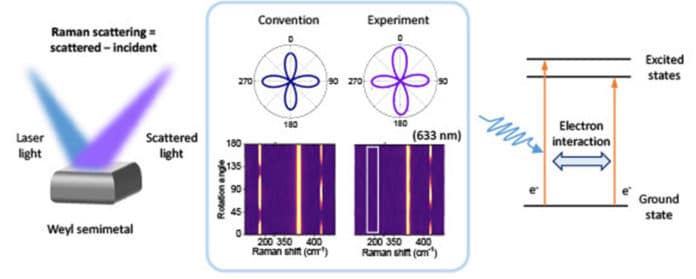Scientists from the Penn State in collaboration with MIT, Tohoku University, Japan, and the Indonesian Institute of Sciences have devised a new method to observe a new class of topological materials, called Weyl semimetals.
Weyl semimetals are materials where valence and conduction bands cross in single points, the Weyl nodes. When the Fermi energy is near these nodes, the electrons effectively behave as relativistic Weyl fermions with a linear energy dispersion and a given chirality.
According to scientists, the material’s unusual electronic properties could be useful in future electronics and quantum physics.
Shengxi Huang, assistant professor of electrical engineering, Penn State, said, “Weyl semimetals are interesting because their electron transport shows some unusual behavior. For example, they can show negative magnetoresistance, which means when you apply a magnetic field, the resistance drops. With many conventional materials, it increases.”
In Weyl semimetals, the electronic band structure is not the same as usual. The electrons have chirality, signifying “handedness.” This chirality is associated with the electrons’ turn and traveling direction. Electrons with left chirality travel the other way of its turn, while electrons with right chirality travel in the same direction of its spin.
Kunyan Zhang, a lead author of the study, said, “Normally, a material would have some conservation, for example, charge neutrality conservation — meaning if you had a certain number of negative charges you would have the same number of positive charges. Similarly, you would also normally have the same number of righthanded electrons as lefthanded ones. But this is not the case in this material, and that seems to boost new electron transport properties.”
Scientists studied the peculiar behavior of the electrons using light that interacts with the electrons and also with the lattice. The interaction causes the atoms to vibrate, creating phonons. The phonons and electrons interact, and the Raman signals — the difference between the laser and scattered light — can show the unusual behavior of the electrons.
The first result of the scientists’ work is to show that the material’s symmetry is broken. On a fundamental level, this crystalline material ought to have four-fold symmetry, which implies that when the crystal is rotated 90 degrees, the property is the equivalent. Nonetheless, right now, the Weyl semimetal is turned 90 degrees, there is a deviation from symmetry.
Scientists noted, “In addition, this material should show three peaks in the Raman spectrum, but in one 633-nanometer — red — light excitation, one peak is missing. That is peculiar. The explanation lies in the band structure of Weyl semimetal. When electrons interact with light, they absorb enough energy to jump to a higher state. In Weyl semimetals, there are many higher states very close to each other. The interaction between the electrons jumping to two adjacent bands can break the symmetry.”
Shengxi Huang, assistant professor of electrical engineering, Penn State, said, “We provide the community with a simple method to understand this material’s electronic behavior. And this method can be generalized.”
Scientists are now planning to study phonon/electron interactions at a reduced temperature, under 10 Kelvin, where the behavior should be quite different.
The study is published in the journal Physical Review B.
